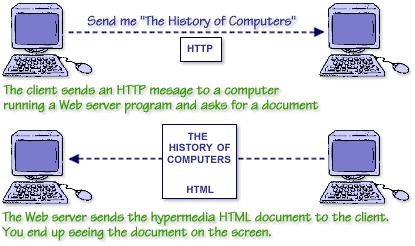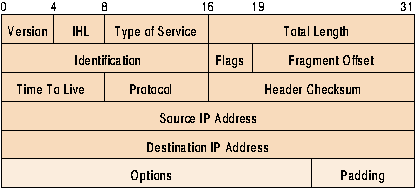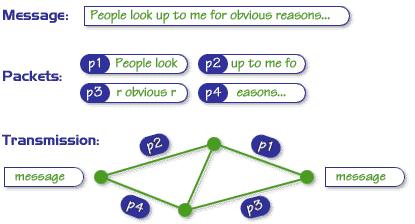Back to Index Page
Web Report
Introduction.
In this report “The importance of protocols in the working of the Internet.”
I hope to convey why these protocols are not just important but vital in
the development and working of the Internet. Without protocols different
parts of the system would not be able to communicate and the system would
be just a set of independent units.
To this end we will look at.
What the Internet is. It as been described as a network of networks
that is a group of linked computers linked to another group of linked computers,
although as you will see a single computer can be linked to the network
and then is able to be connected to any other computer that is online.
But it is the people that use the Internet that defines what the
Internet is.
How the Internet works. We will see how each message whether
it is a picture, a file or a programme is chopped into small segments called
packets and how these packets are given extra information so that they
can all reach their final destination via the best possible route.
What protocols are. These are the rules that allow different
parts of the network to talk the same language. When you meet someone you
say “hello” and shake hands this is a very basic but a very important protocol.
(Computers need to shake hands too)
What is the Internet?
The
T171 team describes the Internet as "a global network of computer
networks" or as the introduction says a network of networks. If you
link the computer in your home or office to another computer you have a
small network as you add more computers the network grows, you can share
printers, disk drives etc. But you are limited to within the home or office.
Now add a modem or one of the other communication devices (cable, satellite
dish) and you can go beyond your home/office and onto the Internet. You
do not need to have a network in your home/office you can link a single
computer known as a client with a modem to the Internet. The modem links
you via a telephone line to another modem belonging to an ISP (Internet
Service Provider) examples are BT Internet and Virgin.net. These company's
use servers and routers to provide links to other ISP's and onto what is
known as the backbone, this is a set of cables and satellites that link
not just towns but countries together. So when you press send on your email
or request a web page you are potentially connected at the speed of light
to every other connected computer in the world.
An example of a client/server connection from the T171
web site

How does it work?
Now we know what it is physically we need to know how it works. Each email
you send or receive, each web page you request every thing you download
(receive from someone) or upload (send to someone) is treated in just the
same way. A set of programmes in your computer takes the information you
want to send cuts it into small uniform lengths and forms what are called
packets. So large files will have lots of packets and smaller files fewer
packets, each packet as some extra information added so that it can be
sent to the right destination and reassembled in the right order.
Here is an example from the (T171
web site) of a packet and an explanation of some of the terms
used.

Source IP Address
So if any packets are missing they can be requested again.
Destination IP Address So it can be sent to
the right address.
Total Length
So it can be determined if any packets are missing.
Identification
So individual packets can be identified.
Time To Live
So that packets can be removed after a given time (32 to 255 seconds) or
the net would just fill up.
These packets are then sent via your modem and the telephone line to
your ISP and on to their destination through routers. Routers are terminals
that read the information that as been added to the packet; using this
information it will send the packet to the next node on rout to the final
destination (IP Destination) or if any are missing it will request a packet
to be resent from the originator (Source IP address) the same process is
gone through at each node until the packet reaches its final destination,
where the TCP/IP programme reassembles all the packets in the right order
and gives them to the relevant programme to process (a sound file to a
player, a document to a word processor etc.)
Here is an example of packet transmission from the T171
web site

More than the some of its parts.
But the Internet is much more than cables, modems and computer screens.
It's people that use the Internet and because of this it takes on a whole
new meaning.
To some it's a communication device allowing families that might be
separated to keep in touch via email or even see each other as they chat
using video conferencing. (When my grand daughter was born (in New York)
I saw my first pictures and a short video of her via the Internet).
To others it's a vast source of information, to a student looking for
a reference to put in there work its a library, its an encyclopaedia to
a schoolboy doing his home work or its just a recipe for jam sponge. What
ever the information you want its available via the net.
Groups of people around the world use it as a vast discussion forum
(known as news groups) what ever your interest you will be able to find
like-minded people to share in your interest, or even argue and debate
with.
It's a shopping mall; it's a business and an education tool.
It's as diverse as the people that use it.
Protocols.
But none of this would work without protocols. Protocols are sets of rules
or standards that have been agreed to allow more than one party to communicate.
Software and hardware have to follow the same rules and because computers
vary in make and specification (this was even more relevant when the Internet
was been developed) these rules or protocols define what action each party
will take. For example when you connect your computer to the Internet it
is just one of millions so your ISP allocates it a unique address in the
form of a set of numbers (62.6.90.85 is mine at the moment) this is known
as the Internet Protocol or IP. As you my have noticed above IP is normally
associated with TCP (Transmission Control Protocol) and wrote together
as TCP/IP. While the IP protocol looks after the addressing the TCP protocol
takes care the packets. By adhering to these two protocols any computer
no mater what make or operating system it is using can send/receive these
packets of information to or from any other computer that is connected
to the Internet.
An aspect of the Internet that is talked about a great deal these days
is the World Wide Web (WWW) and here too protocols play an essential role,
from the address of the page the URL (Uniform Resource Locator) through
the make-up of the page HTML (Hypertext Mark-up Language) to the way the
page is sent from machine to machine HTTP (Hypertext Transport Protocol).
Amazingly all these WWW protocols were invented by one man working
at CERN (The European Centre for Nuclear research) laboratory in Geneva
his name is Tim Berners-Lee and he did it in just over a year.
(John Naughton 1999) describes this achievement in his book "A Brief
History of the Future" in these glowing terms.
"Looking back, it is not so much the elegance of Burners-Lee's creation
which makes one gasp at its blinding comprehensiveness. In just over a
year he took the Web all the way-from the original conception, through
the hacking out of primitive browsers and servers, to the creation and
elaboration of the protocols needed to make the whole thing work. And on
the seventh day he rested."
Conclusion.
The importance of protocols in the working of the Internet.
We have seen that the Internet is a global network of networks allowing
every connected computer to connect to every other connected computer and
that each message or piece of information no mater what its form is chopped
in to byte sized pieces called packets. These packets then travel
at the speed of light too or from their destination.
But it is the protocols; these rules that govern how each party communicate
that allow different systems to join seamlessly together. With out these
protocols the Internet could not have grown as quickly or to the vast size
it is today and to simply click on an icon to receive your desired information
would be just a dream.
With the increasing use of the Internet for online shopping and e-commerce
(business activities and share dealing) protocols are going to be even
more important for a safe, secure and stable environment.
The Internet may be as diverse as the people that use it, but the protocols
are the same for everyone and it's these protocols that makes the Internet
work.
References.
-
Herman C. Taylor E. Robinson L. (2002) Module 2 [online] The Open
University. Available from:
http://t171.open.ac.uk/t171/module2 [Accessed 25 June 2002]
-
Naughton, J. (1999) A Brief History of the Future, London, Weidenfeld
& Nicolson.
Top
Back to Index Page
